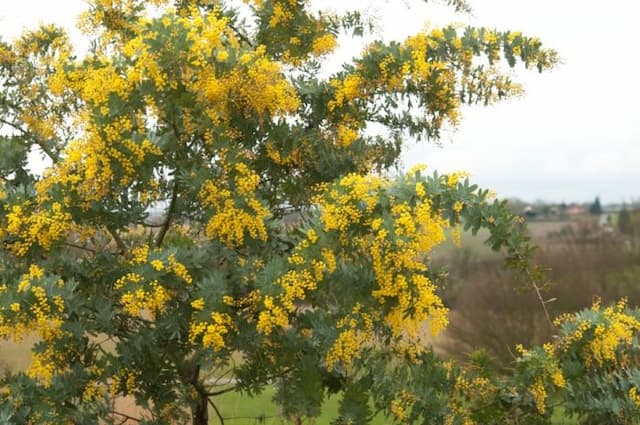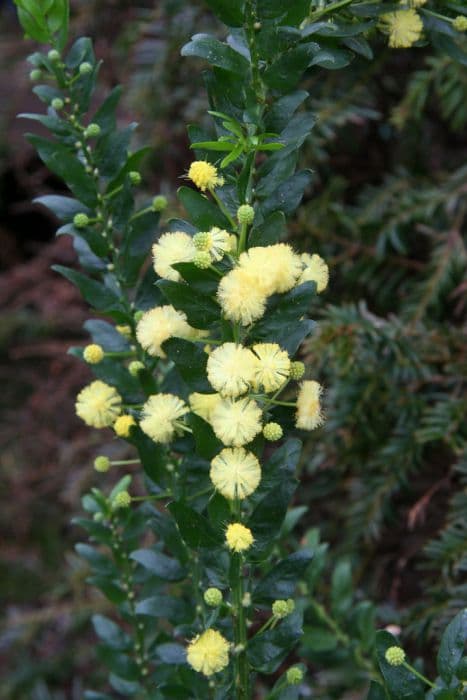Chinese wisteria Wisteria sinensis 'Prolific'

ABOUT
The Wisteria sinensis 'Prolific', commonly known as Chinese wisteria, is a visually striking plant with a graceful and flowing appearance. This variety of wisteria is particularly known for its abundant and long cascades of fragrant flowers. The flowers are a soft, bluish-purple, and they hang in grape-like clusters called racemes, which can create a breathtaking display of color and texture. The leaves of the Chinese wisteria have a vibrant green hue that provides a beautiful contrast to the blooms. The leaves are compound, usually composed of 7 to 13 leaflets per leaf, and they have an elliptical shape with a smooth or slightly wavy edge. Throughout the seasons, the appearance of the Chinese wisteria changes. During the spring and summer months, the plant is adorned with its lush foliage and floral splendor, while in the fall, the leaves often turn yellow, adding a different dimension to the garden landscape. After the leaves drop, the bare branches and woody stems, which can be artistically twisted, are revealed, giving the plant a sculptural quality, even in the absence of its leaves and blooms.
About this plant
 Names
NamesFamily
Fabaceae
Synonyms
Chinese Wisteria, Prolific Chinese Wisteria
Common names
Wisteria sinensis 'Prolific'.
 Toxicity
ToxicityTo humans
Wisteria is known to be poisonous to humans if ingested. All parts of the plant contain compounds such as lectin and wisterin, which can cause gastrointestinal distress. Symptoms of poisoning may include nausea, vomiting, diarrhea, and abdominal pain. In severe cases, the toxicity can lead to dehydration, electrolyte imbalances, and could be life-threatening. Caution should be taken to ensure that children and adults do not consume parts of the wisteria plant.
To pets
Wisteria is also toxic to pets and can cause similar symptoms as seen in humans. Ingesting parts of the wisteria plant, including seeds and pods, can cause vomiting, diarrhea, abdominal pain, and depression in pets. In severe cases, it may lead to dehydration, weakness, and collapse. Pets may be particularly at risk since they might be more likely to chew on plants when outdoors. It is important for pet owners to prevent their animals from ingesting any part of the wisteria plant.
 Characteristics
CharacteristicsLife cycle
Perennials
Foliage type
Deciduous
Color of leaves
Green
Flower color
Lilac
Height
10-25 feet (3-7.5 meters)
Spread
10-30 feet (3-9 meters)
Plant type
Climber
Hardiness zones
5
Native area
China
Benefits
 General Benefits
General Benefits- Aesthetic Appeal: The plant produces abundant cascades of fragrant, blue-violet flowers each spring, enhancing garden landscapes and outdoor spaces.
- Shade Creation: Wisteria sinensis 'Prolific' can be trained over pergolas and arbors to provide natural shade during hot weather.
- Erosion Control: The robust root system can help stabilize soil and control erosion on slopes and banks.
- Habitat for Wildlife: It offers food in the form of flowers and shelter for a variety of birds and beneficial insects.
- Privacy Screen: When grown on fences or trellises, Wisteria can create a dense screen, offering privacy from neighbors and passersby.
- Seasonal Variety: Offers seasonal interest with its spring flowers, summer foliage, and sometimes attractive seed pods in the fall.
 Medical Properties
Medical PropertiesWisteria sinensis 'Prolific' is not used for medical purposes.
 Air-purifying Qualities
Air-purifying QualitiesThis plant is not specifically known for air purifying qualities.
 Other Uses
Other Uses- Biodegradable pots: The vine's fibrous material can be woven into pots that naturally decompose, reducing the need for plastic in gardening.
- Urban greening: Wisteria can be used to green walls and fences, aiding urban biodiversity and providing habitats for insects and birds.
- Artistic medium: Dried wisteria vines are strong and pliable, making them suitable for creating sculptures and other art pieces.
- Living tunnels: With its robust climbing habit, wisteria can be trained over structures to create enchanting walk-through tunnels in gardens and parks.
- Educational tool: Wisteria's vigorous growth can be used to teach principles of botany and plant training in educational settings.
- Natural dye: The flowers and seed pods can be used to create natural dyes for textiles, offering a range of soft purple and brown hues.
- Floral arrangements: Cut wisteria flowers can be used in large, cascading floral arrangements and installations due to their dramatic appearance.
- Canopy shading: Planted in larger gardens, wisteria can provide natural shading when grown over pergolas and arbours.
- Photography backdrop: Wisteria's impressive blooms are often used as scenic backdrops for photography, especially for weddings and events.
- Aquatic composting: When pruned, the wisteria clippings can be used as compost in ponds to support aquatic plants and balance the ecosystem.
Interesting Facts
 Feng Shui
Feng ShuiWisteria is often used in Feng Shui for its qualities of promoting positive energy. It can be planted in the garden to bring a sense of beauty and grace and to enhance the energy flow. The lush growth and cascading flowers of Wisteria symbolize abundance and prosperity, making it a beneficial addition to spaces that require these elements, such as the wealth or family sectors of a home or garden.
 Zodiac Sign Compitability
Zodiac Sign CompitabilityWisteria is not used in astrology practice.
 Plant Symbolism
Plant Symbolism- Welcome: In some cultures, wisteria is planted near the entrance of homes as a symbol of a welcoming environment, inviting guests in with its lush cascades of flowers.
- Longevity and Immortality: Wisteria is known for its long life and ability to survive and thrive for many years, often outliving the people who planted them. This has led to its association with longevity and immortality.
- Love and Romance: The intoxicating fragrance and the captivating draping blooms often evoke feelings of love and romance, symbolizing new beginnings or the intense swooning associated with passionate love.
- Good Luck: In East Asian culture, particularly in China, wisteria is a common symbol of good luck and is frequently found in art and cultural expressions with this association.
- Patient Progress and Exploration: The way wisteria grows, slowly expanding and exploring its environment, has led to its symbolism of steady progress, development, and the patient pursuit of one's aspirations.
 Water
WaterChinese Wisteria needs regular watering, particularly during the spring and summer growth seasons, to thrive. An established plant should be watered deeply once a week with about 1 to 1.5 gallons of water, ensuring moisture reaches the deeper roots. In hot or windy weather, increase the frequency to twice a week to prevent drying out. During winter, reduce watering as the plant goes dormant, providing enough water to keep the soil slightly moist. Always check the top inch of the soil before watering; if it's dry, it's time to water.
 Light
LightChinese Wisteria prefers full sun to partial shade, thriving best when it receives at least 6 to 8 hours of direct sunlight daily. The ideal spot would be against a south or west-facing wall or trellis that provides ample sunlight and warmth. Partially shaded areas can be tolerated but may result in less prolific flowering.
 Temperature
TemperatureChinese Wisteria thrives in temperate climates and can survive in USDA hardiness zones 5 through 9, which correspond to a temperature range where winter lows don't typically drop below -20 to -10°F. They perform best in temperatures between 60°F and 80°F during the growing season. Extreme heat above 100°F may cause stress, while the vines are hardy enough to withstand winter temperatures as long as the roots are well-protected.
 Pruning
PruningChinese Wisteria requires pruning to maintain shape and encourage flowering. Prune twice a year, cutting back long shoots in late summer after flowering and then tidying up and cutting back further in mid-winter to about 3 to 5 inches above a bud. Pruning controls the rampant growth and prevents the plant from becoming too woody, which could impede blooming.
 Cleaning
CleaningAs needed
 Soil
SoilChinese Wisteria prefers a fertile, well-draining soil, with a pH of 6.0 to 7.0. A mix of loamy soil, compost, and gritty material like perlite or coarse sand is ideal for this plant to thrive.
 Repotting
RepottingChinese Wisteria should generally be repotted every two to three years, or when it becomes root-bound. This ensures continued growth and blooming.
 Humidity & Misting
Humidity & MistingChinese Wisteria flourishes in average outdoor humidity levels; it is not particular about humidity when grown in its natural outdoor environment.
 Suitable locations
Suitable locationsIndoor
Place in bright light, ensure strong support for climbing.
Outdoor
Full sun, provide sturdy support for growth.
Hardiness zone
5-9 USDA
 Life cycle
Life cycleWisteria sinensis 'Prolific', commonly known as Chinese wisteria, begins its life cycle as a seed, which upon germination produces a small seedling. The seedling grows rapidly, developing a robust root system and woody, twining stems that enable it to climb on supports. In its juvenile stage, it focuses on vegetative growth, expanding its reach and foliage but rarely flowering. After several years, this plant enters its mature phase, characterized by the prolific blooming of fragrant, purple-blue flowers in late spring, often before the foliage unfolds. Following pollination by insects, the flowers develop into hanging seed pods that mature in summer and can disperse seeds for reproduction. Chinese wisteria is a perennial plant and can live for many years, continuing to grow and bloom annually, with established vines requiring regular pruning to manage size and promote flowering.
 Propogation
PropogationPropogation time
Spring-summer
The optimal time to propagate the Chinese Wisteria 'Prolific' is in the late winter to early spring, just before the growing season begins. This timing allows for better root development before the full onset of growth. The most popular method is by softwood cuttings taken from new growth that is not yet mature. To propagate from cuttings, cut a section of the vine that is around 6 inches (15 centimeters) long, ensuring it has a few leaf nodes on it. Remove the leaves from the bottom half of the cutting to prevent excess moisture loss and dip the cut end into rooting hormone to encourage root growth. The cutting should then be planted in a mix of peat and perlite, kept moist, and covered with a plastic bag or dome to maintain high humidity. Place the cutting in indirect light and wait for several weeks until new growth indicates that roots have formed, at which point it can be transplanted to a larger container or to a prepared spot in the garden.









